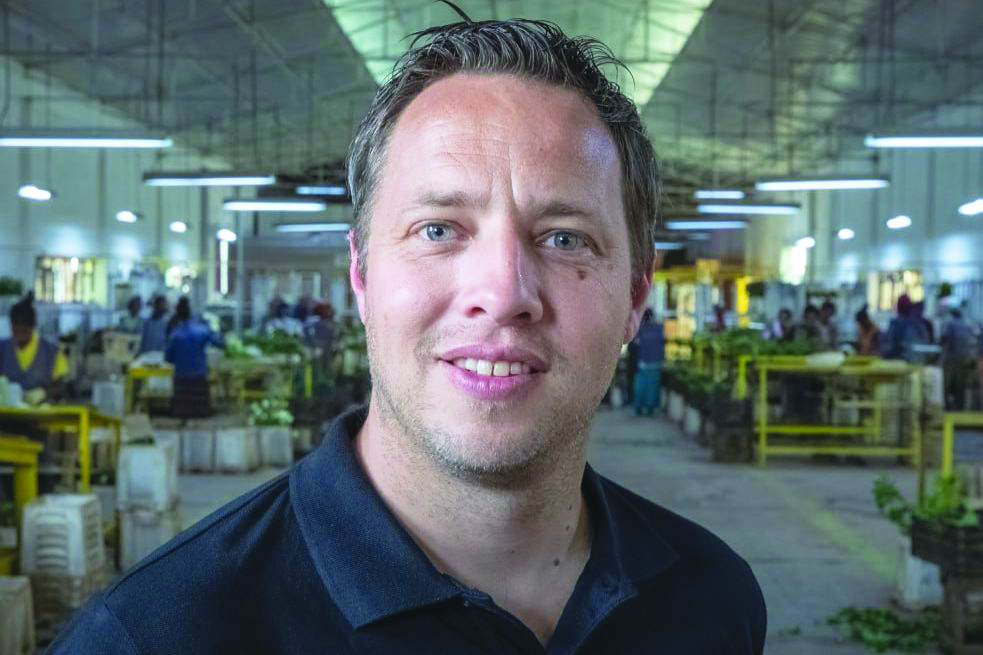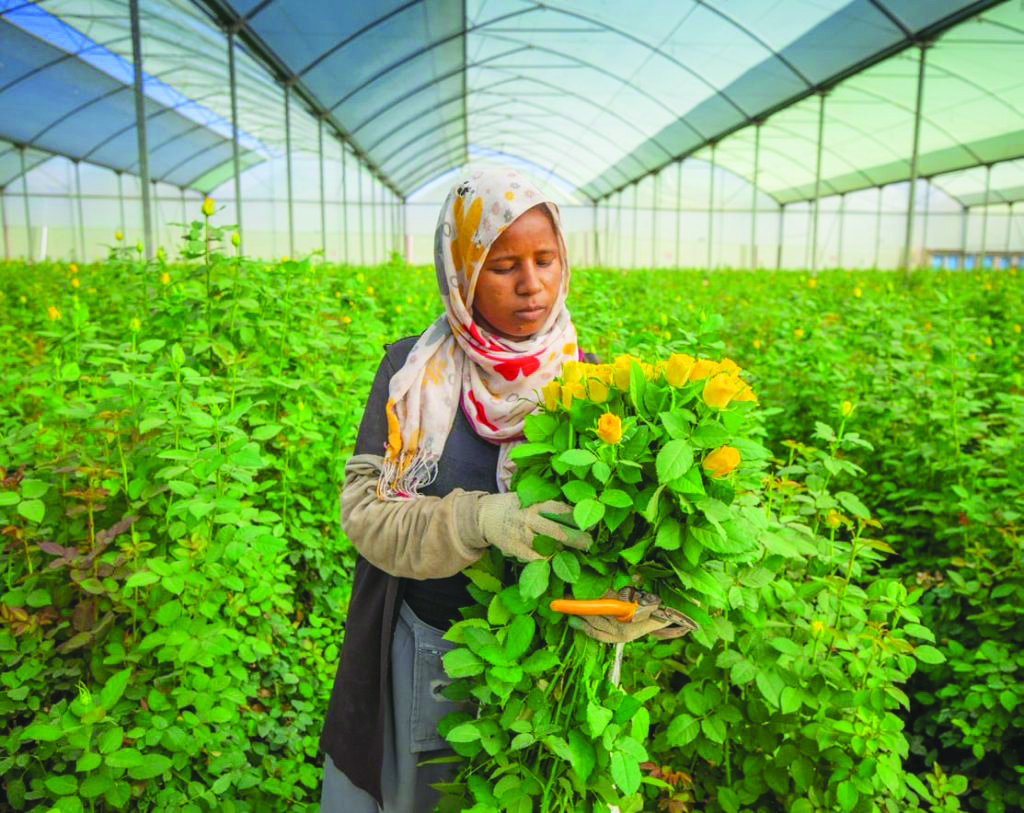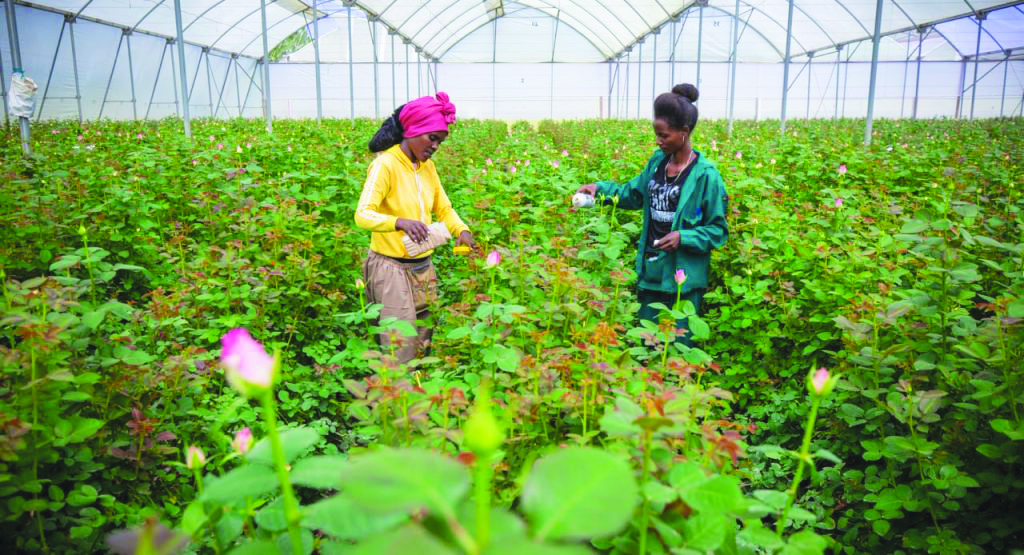
In 2006, Frank Ammerlaan and his brother Win backed by their parents began growing roses in Ethiopia. The family-owned AQ Roses cut rose nursery has grown by leaps and bounds over the past eighteen years with the latest addition being an 18ha nursery in Bishoftu/Debre Zeit.
Nestled at an altitude of nearly 2,000 metres, this former Dümmen Orange rose cut rose nursery serves as a perfect location to grow large-headed roses for the higher end of the market and 2ha of Alstroemeria as a side crop.
On the outskirts of the Ethiopian town Ziway/Batu, the brothers continue to grow roses for supermarkets and traditional wholesale. The two growing locations combined span an area of 50ha and employ more than 1,000 people.
Frank, it’s now 18 years since you first set up your farm in Ethiopia. What is the biggest commercial success of venturing into an emerging market?
Our sales and distribution channels continue to be in Europe and, as such, in Western countries. However, in Ethiopia, we found a very suitable environment to grow our roses, that is, a colour palette of roses in a variety of sizes. Such an achievement would never have been possible in the Netherlands. I also dare to say that the blooms we currently grow in Ethiopia are of better quality than we ever produced in our home country. Improved rose breeding and growing techniques have been important factors that have contributed to this success.”
How did the Ethiopian adventure enrich your life as a person?
Living and working abroad, being exposed to a culture that is different and a diverse range of people, is an enriching experience that has helped me to grow as a person. As incredible as it sometimes is, living abroad is not without struggles and challenges, and it’s that mix that helped me to develop a clearer sense of self and become someone who is less likely to let himself off the hook. The adventures in a country like Ethiopia will stay with me forever.”
If you were to write a new business plan for growing roses in Ethiopia, which paragraphs would be added, adjusted, or omitted?
Ethiopia 20 years ago was completely different than it is today. The situation has changed dramatically over the past 20 years.

In the first two decades of the new millennium, the country’s economy grew by seven per cent annually per capita but also turned out to be less ‘innocent’. Today, safety and societal factors weigh in much more when assessing the business climate. When setting up camp 20 years ago, we primarily focused on the production nursery, while today, we would dedicate a much bigger paragraph to risk assessment.”
Discuss government Incentives during your inception and now.
At the time, our decision to move our production to Ethiopia was certainly not driven by the government’s investment incentives. Many of them, including tax reliefs, remained unused. More importantly, the government had created a business environment in which we felt welcome. Next to providing a stable and secure investment climate, the public authorities did their best to address side issues. Things are different now. Floriculture is no longer one of the few success factors behind the country’s economic growth as many other sectors of the economy gain momentum. So, the approach towards the floriculture sector is under much more scrutiny. Many incentives are still in place, but the investment climate has become much more unpredictable.
Under the brand name RosaPlaza, you grow and sell approximately 100 million roses, of which 50 per cent are sold through Royal FloraHolland’s auction clock. In January 2023, you joined the auction’s Supervisory Board to help the cooperative navigate its transition process. How do you perceive the future role of the auction clock?
I am convinced that Royal FloraHolland’s future role in the global flower and plant trading arena will become even more important and impactful. Transitioning into the world’s largest floral trade hub. In such a situation, many new opportunities will arise with Royal FloraHolland providing an extended set of services to both growers and customers, particularly in the realm of day-to-day trade.
Industry experts predict that trade will become increasingly direct, marked by bypassing the Dutch flower auction and the Netherlands’ logistical hub. What’s your stand on this?
As stated before, Royal FloraHolland’s can predominantly add value to day-to-day trading; I expect many growers eventually to realise that this value addition will help them in selling their products, simply because the co-op’s trading platform is easily accessible and therefore more efficient than having to arrange everything on your own account. This also applies to customers.”

In an era of vertical business integration, cutting out middlemen, environmental concerns, and political and societal pressure, would you put all your money on the flower auction?
You should never put your eggs in one basket. Yet, I am convinced that horticulture will continue to exist and flourish worldwide, with Royal FloraHolland continuing to play a primordial role. I don’t know of any other joint association of growers which is so strong.”
Advise millennials and Generation Z who view the practice of cultivating cut flowers for export on a continent where a third of the population is malnourished as a modern and environmentally unfriendly form of horticultural imperialism?
The answer, in essence, is very simple. Africa’s population will continue to increase, and all these people, quite rightly, seek higher living standards. This situation will put greater strain on natural resources such as land and water. In this context, the single best solution is tech that can change the way the world grows, produces, distributes and supplies food. To realise this, you need a thriving economy, and that is what we, as a flower farm, contribute to. In addition we witness a prime example of knowledge exchange with people seeing how things can be done better in daily practice. Ultimately, this will lead to less pressure on natural resources than when using traditional farming techniques.
Ethiopia is described as Africa’s second largest and the world’s fourth largest flower exporter. Is it justifiable?
Ethiopia’s floriculture business has gone through much progress over the course of 20 years, despite the challenges that growers in Ethiopia have faced. Nevertheless, I believe that, for some reason, there is still much untapped potential. So, it is justifiable.
Today, Ethiopia’s ornamental horticulture sector represents a dynamic industry with more than 100 flower farms covering a total production area of around 1,700 ha. Within Ethiopia’s borders, what changes do you see in the geographical concentration of farms, crops and land areas dedicated to floriculture?
In the end, only a few spots in the world are truly suited for floriculture. Weather and climate play a decisive role, and in that. Yet, logistics and connectivity are also at stake. If more areas in the country become unlocked, more flower-growing areas will be available. But even then, new production areas will always emerge close to already existing horticultural heartlands.
More recently you have added Alstroemeria to your product range. Was that decision driven by concerns of an oversupply of roses in the world market or do you think there’s a correct market equilibrium in the global marketplace for roses?
“Alstroemerias make great cut flowers, boost an excellent shelf life, and perfectly match our business model. Our Alstroemerias are there to complement our product offer and definitely not because an oversupply of roses forced us to look for alternatives. Ultimately, when the weather holds out well and growing conditions are conducive, there’s an overproduction of roses. In turn, what we have seen over the past 20 years is that when there are lower production volumes in specific areas, market demand for roses can be stellar high.
With a new year lying ahead, there’s always the temptation to ask you about the predictions for 2025 Valentine’s Day rose sales. What would be your answer?
Thankfully, I cannot look into a crystal ball. Today, as in the past, climate is clearly one of the most important factors in the success of cut roses. Market equilibrium between supply and demand is highly weather-dependent. We are fortunate that we are not only growing Valentine’s roses but also striving to offer our customers quality blooms year-round. So, whether Valentine’s Day sales will be good or bad is not something that keeps me awake at night.”
Understanding your heritage is an important part of carving out your future. AQ Roses has been founded on many years of expertise. Dutch rose growing has witnessed a serious decline. What would be your message to the remaining Dutch diehards who still keep an unshakeable belief in Dutch-grown roses?
Dutch-grown roses are unique, and as long as growing them is profitable, demand for Dutch roses is here to stay. The success of Dutch roses is also our success. The reality is that nowhere in the world is there a retailer that sells flowers produced by one single grower or sourced from one production area only. And no flower trader sticks to one single flower type. It all boils down to product diversity. And the cream of rose production – represented by Dutch growers – will continue to play a very important role, and there will always be a place in the market.”
What’s next for AQ Roses?
We will continue to build on the expertise gained over the past 20 years. Our aim is to take production to an even higher level, giving way to further business expansion and a lower carbon footprint.”
Source: EHPEA, Original Source FCI-Edited.
